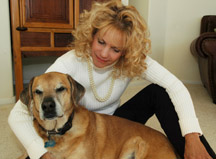We are truly connected.
Besides the enormous spiritual and social implications of this rather recent discovery (1996 in Parma, Italy), it explains why words hold sway the way they do and why what we say to our children--particularly when they are hurt, confused, shocked, or sick--matters the way it does.
Reassurance is good and necessary. But Verbal First Aid goes farther. Our words--in generating images and inspiring neurologic and biochemical responses--hold sway over their physical and emotional response to any given situation.
What children see in us, feel from us, and hear from us, they become. Literally .
How we respond determines how they respond. And not only in that moment, but for the future.
Janie is a five-year old like any other--quick to run, slow to stop. As she runs around the yard with the family dog, she trips on a hose and lands squarely on her chin. She is stunned and momentarily distracted by the dog as he runs back to her and licks her face. Then she realizes she is bleeding and a wail alerts her father, who is working in another part of the yard. He rushes to her.
He has two options at this point.
He can become irate and/or hysterical, alternating between anger and fear for his child, which could sound something like this: "How many times have I told you not to run around like that, that you'd get hurt and now look what you did? Oh, God, look at that gash on you. Oh, for goodness sake, Janie. We have to get you to the hospital. Where are your shoes?"
Or, he can take a breath, approach her calmly and gently examine the situation, which might sound like this:
"Janie, I'm right here, honey. I've got you. Come. Let me see what's going on that sweet chin. Well, looks like you're bleeding pretty well and cleaning the wound out. That's really good, sweetheart. And it looks like you've done that enough for now, so you can go ahead and start healing that boo boo, while I get something to clean it with and call the doctor. We may need some special doctor magic to make it go away for good. But you're pretty good at magic, too. So, you wanna come help me with this?"
In the first scenario, Janie is not only hurt and frightened by her own mistake, but by her father's anger, disappointment and fear. His reaction to her intensifies logarithmically whatever fear she already had. As a result, her biochemistry is responding instantly with substances that actually impede healing.
In the second scenario, Janie is calmed, reassured and held by her father's presence. In addition--and perhaps most importantly--he refers her to herself as a primary source of comfort and healing.
***
When I read that second sample to my husband who was raised in Montana by loving but very stoic parents, he said, "No one ever spoke to me that way. I got my leg wrapped around a bicycle gear once and rolled down the hill that way. I got brushed off, the gears got put right, and we rode home. My mother cleaned me up and held me, but we were expected to handle it. That was life. I heard a lot of "Oh, dear, cut it out.'"
Our ability to deal with fear as children is the foundation for the way we deal with fear as adults--both for ourselves and with our kids. Most of us were not raised with these ideas and some of them may feel awkward or even seem unnecessary, especially if we ourselves were dismissed when we were afraid or hurt. Most of my colleagues remember being told to "buck up" when they got cut or bruised, especially the men.




